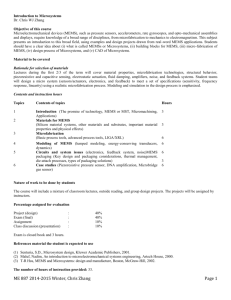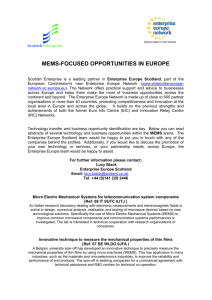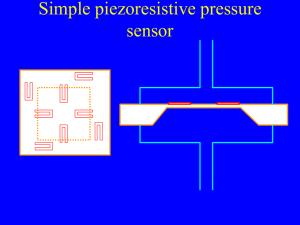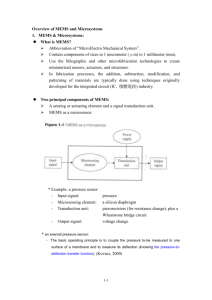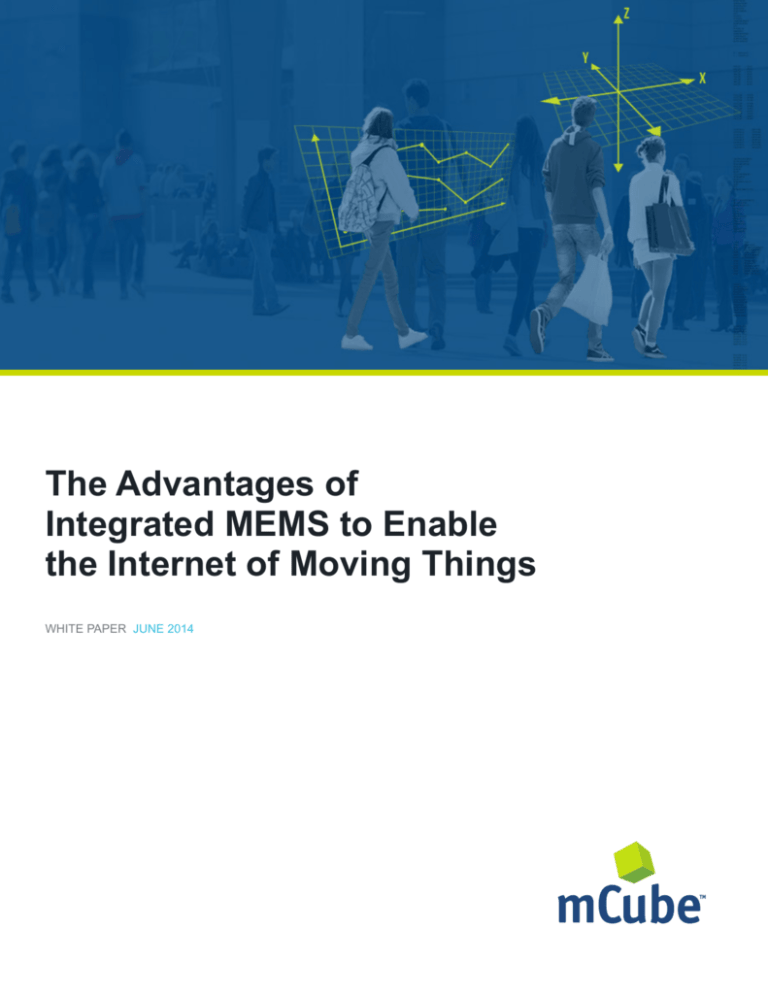
The Advantages of
Integrated MEMS to Enable
the Internet of Moving Things
WHITE PAPER JUNE 2014
The availability of contextual information regarding motion and direction is transforming consumer device
applications. Games, 3D user interfaces, contextual awareness, and navigation applications have increased the
demand for MEMS sensors to deliver real-world, motion-aware applications that enrich the consumer experience.
While these devices started in automotive and industrial applications, they have quickly become ubiquitous in
gaming controllers, smartphones and tablets. That wave is now growing into an expanded Internet of Moving Things
(IoMT) including smart wearables, sports equipment, and medical devices where the size and weight requirements
have previously limited options for interfacing to these devices through motion sensing. Recently the need to meet
size, power, and functionality requirements for these new markets has fueled a new wave of innovation in sensors.
In fact, a new era of sensors is emerging where MEMS devices can provide designers with novel methods of user
interaction and a self-aware quality that is compelling and driving new use cases in the Internet of Moving Things.
In Figure 1 you can see the evidence of this trend come to life with the steep reduction in accelerometer sensor
size over the years. These reductions in size were largely achieved by optimizing existing designs and packaging.
Minimum features have been pushed to physical limits and further advancement is now limited by the overhead of
chip interconnectivity.
Another method for reduction in size involved combining multiple degrees of freedom (DoF). Accelerometergyroscope, accelerometer-magnetic sensor 6-axis products, and even 9-axis accel-gyro-mag products have come
onto the market. The majority of these products, however, use the same MEMS processing at the wafer level.
Integration and size reduction was accomplished by chip stacking of discrete sensor and CMOS die in assembly.
To truly accelerate the trend toward substantial reductions in size will require real innovations in the underlying
fabrication technology. The next phase in MEMS sensor evolution will require integration of MEMS sensors with
electronics in a competitive, monolithic process. Not only will this improve economy, performance, and functionality,
MEMS & SENSORS
it also will enable a chip-on-board (COB) approach not possible with solutions that require multiple die.
Accelerometer MEMS size evoluon
(Source: Ineral MEMS Manufacturing Trends, Vol. 1&2 report, Yole Développement, March 2014)
All are 3-axis accelerometers
ST LIS3L02AE
Figure 1: Needs of consumer
products are driving a rapid size
evolution of MEMS Sensors.
MEMS Size (mm²)
12
BOSCH
SMI540
5
ST LIS331DLH
VTI
CMA3000
4
3
ST LIS3DH
Kionix KXTE9
2
2007
CONSUMER
WHITE PAPER
2008
2009
ADI
ADXL346
BOSCH
BMA250 /
BMC050
2010
2011
ST LSM330
mCube
BI3L
ST LSM303D
ADI
ADXL362
2012
© March 2014
ST LIS302DL
BOSCH BMA180
2013
AUTO
2
Integrated MEMS
Integrating microelectromechanical structures (MEMS) with electronics is not new. Commercial production
of a monolithic MEMS device was first achieved in the mid 1990’s. Despite the technical achievement, the
market, in particular the consumer device market, preferred two-chip solutions, due to limitations in the original
monolithic approach:
n
Area inefficiencies: When MEMS were fabricated adjacent to CMOS, all the expense of processing unused
area (i.e. MEMS processing before CMOS or vice-versa) was wasted and could not be recovered.
n
Lower yields: The higher level of complexity in an integrated process lead to lower yields.
n
Advances in packaging: Wafer thinning and stacking eroded the potential advantages integrated products
were expected to achieve over two-chip solutions.
For these reasons, multi-chip solutions for accelerometers, gyroscopes, and pressure sensors have been the
mainstay in the consumer market, but they are increasingly challenged to meet the size and cost reduction
requirements without further sacrificing features and performance.
mCube is the first company to successfully bring to market an integrated MEMS+ASIC that does not suffer from
these drawbacks. The mCube monolithic single-chip structural design offers:
n
High yields
n
Very efficient area usage
n
Superior interconnectivity between MEMS and CMOS
n
Significantly smaller footprint for devices with equivalent transducers
n
Complete functionality at wafer level
A schematic cross-section is shown in Figure 2. Released MEMS structures are fabricated directly on top of
standard CMOS, integrating the two more efficiently than in any previous commercial MEMS process.
Figure 2: The mCube monolithic, single-chip
platform, shown above in a schematic cross-section,
integrates MEMS with CMOS more efficiently than
in any other commercial MEMS product.
WHITE PAPER
3
Process Overview
An overview of the major steps in the process is shown in Table 1.
The substrate for the MEMS process is a standard CMOS wafer.
All processes to this step are standard foundry processes.
After patterning bond pads and release areas, a single crystal silicon
wafer is bonded to the surface of the CMOS. The wafer is ground
down to the target thickness.
Electrical connections are created between the MEMS and the
underlying CMOS with specialized MEMS via. The MEMS structures
are then patterned.
A cap is bonded over the MEMS structures at the wafer level.
The MEMS is protected in a hermetic environment.
Table 1: The integrated MEMS process of the mCube accelerometer is efficient.
The process for the mCube accelerometer is able to overcome the historical drawbacks of an integrated MEMS
process because of several key features:
n Vertical integration: MEMS structures are processed directly on top of CMOS. Unlike side-by-side or adjacent
approaches, there are no significant keep-out rules or reserved processing areas that lead to an inefficient use
of area.
n
Truly monolithic: Because the MEMS features of the mCube
accelerometer are defined lithographically, the alignment tolerance
between MEMS and CMOS in the mCube accelerometer is 0.1 µm.
The overhead is much less compared to MEMS wafer bonding,
where the alignment tolerance of 3-5 µm must be accommodated in
every feature.
n
Minimal size of interconnection: The MEMS via in the mCube
accelerometer is only 3 µm in diameter.
An example device is shown in Figure 3. The MEMS area has been
decapped to show the underlying structure. The complete interface to
the device, including all testing, is accomplished with eight bond pads.
The process has several benefits that are particularly critical in the
consumer markets of phones and wearables.
WHITE PAPER
Figure 3: This SEM of the mCube
accelerometer shows the MEMS structure
monolithically integrated with the ASIC.
4
Size
Size reduction is achieved by significantly reducing the bond pads
and their required overhead, (e.g. ESD protection) from the die real
estate. This is accomplished with MEMS vias that ohmically connect
the MEMS to the underlying CMOS directly. The vias shown in Figure
4 are only 3 µm in diameter. In a typical comparison such as that
shown in Table 2, the integrated approach can have four times fewer
bond pads than a two-chip approach.
Figure 4: These vias in a mCube
device are directly connected
to CMOS underneath.
Approach
CMOS
MEMS
Two Chip
23
Integrated
8
Total
No.
Area
9
32
90.1 x 103 µm2
–
8
22.7 x 103 µm2
Table 2: An integrated device can have four times fewer the number of bonded connections as a two chip approach
for an accelerometer.
Cost
Figure 5 compares the cost vs. aggregate yield of a two-chip MEMS
solution with an integrated device of comparable technology and
performance. It shows that at lower yield, the two-chip approach
has an advantage, primarily because of the ability to sort and pair
known good MEMS with known good CMOS in assembly. In an
integrated approach, if either the MEMS or the CMOS portion is
defective, the entire product is lost. The integrated device, however,
has a steeper reduction in cost owing to the smaller area in silicon
for interconnecting the MEMS and CMOS, reduced test cost (one
wafer load vs. two), and significantly lower assembly costs. At higher
yields, an integrated device can have a lower total cost.
The advantage of bond pad savings for MEMS-CMOS
interconnections becomes even more pronounced when considering
devices with multiple degrees of freedom (DoF) such as a 6-axis
accel-gyro combination.
WHITE PAPER
Figure 5: The cost vs. yield curve is
steeper for an integrated device.
5
Performance
In sensors that respond with a change in position (e.g. accelerometer, gyroscope, pressure), the preferred
method of measuring that change in applications that are sensitive to power consumption is to measure a change
in capacitance. Approaches that measure a change in resistance or frequency tend towards higher power
consumption.
A second consideration in the performance of the device is the parasitic coupling of interfering signals. Whether
the objective is to reduce the EMI cross section or shield from coupling to undesired signals like clock or
communication, the MEMS via approach has a significant advantage over running long traces to bond wires
between two chips. The intimate coupling of the MEMS to CMOS is inherently much easier to safeguard against
interference.
Chip-on-Board
Up to this point, this paper has compared the advantages of an integrated device versus a multi-chip approach
using attributes common to both. One particular benefit that is unique to the mCube monolithic, single-chip device
is that it is a fully functional, self-contained product at the die level. Customers can consider using a chip-onboard (COB) assembly. The overhead of trying to do this with a multi-chip product would eliminate any potential
advantage of this approach, particularly in the design of wearables and other space-constrained devices.
mCube’s single-chip MEMS+ASIC design makes this unique form factor possible.
In addition, because it is not possible to know in advance which ASIC is married to which MEMS at a customer’s
site, no wafer-level trimming can be performed prior to assembly with the multi-chip approach. In contrast, the
monolithic, single-chip approach can test and trim many of the analog functions at the wafer level prior to shipping
known good die because the MEMS and ASIC are a single chip. Chip ID numbers are also programmed into onetime programmable (OTP) memory, providing full traceability for both MEMS and ASIC processes back to
the foundry.
Conclusion
The integrated monolithic, single-chip process and structural design enables mCube to ship the world’s smallest
integrated accelerometer in volume. It can achieve this size without sacrificing performance or features. The
savings from reduced size, lower testing costs, and lower assembly costs also enable this integrated approach to
be very cost effective. While this approach has some advantages in the smartphone and gaming market, it offers
an attractive path of continued innovation especially for designers of wearables and smart clothing.
ABOUT MCUBE
2570 N 1st St, STE 300
San Jose, CA 95131
Phone: (408) 637-5503
www.mcubemems.com
info@mcubemems.com
mCube makes the smallest motion sensors in the world. As a technology leader, mCube aspires to be the enabler for the
Internet of Moving Things by putting a MEMS motion sensor on anything that moves, improving the way consumers live and
interact with technology. mCube is backed by leading investors and has already shipped over 60M units. For more information,
visit www.mcubemems.com. Follow mCube @mcubemems.
Copyright 2014. All rights reserved. mCube, Inc., the mCube logo and certain other mCube trademarks and logos are trademarks
and/or registered trademarks of mCube, Inc.
0614






